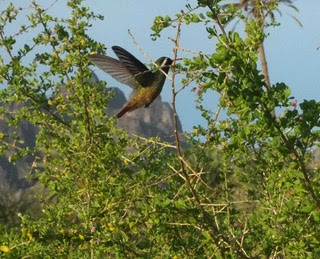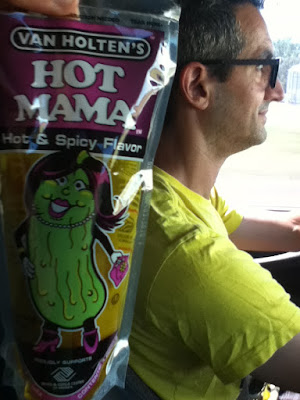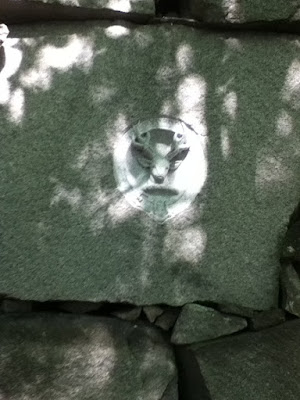The whole trip was just under 4000 km and a whole tonne of hours in the van. Thankfully we had zero problems, either with the van or any of the military and police check-points. And that was even with knowing essentially no Spanish!
Our friend Kyle gave us a piñata bull, named Larry, right before we left and the guys at the military check points got a kick out of every single time. We're not sure if piñatas are just really popular in Mexico or if they were laughing at our painfully obvious gringo-ness in having one--but either way I was glad it put them in a good mood. The only downside was that Larry had an unfortunate cavity search by one soldier (if you know where you put the candy into a piñata, you know what I mean).
We started from Mexicali and after the quiet, laid-back environment of Calexico on the US side, it was a rude awakening. It was pretty chaotic and not the nicest way to figure out how driving is done in Mexico. Turns out you only stop at stop signs if you absolutely have to...otherwise it's just a suggestion. The kind of great thing about that is everyone goes slow and watches closely as they go through, instead of assuming they can barrel through if it's 'their' turn.
There is a pretty sad shanty town on the outskirts of Mexicali. Tiny homes are trendy in North America, and probably palaces for these Mexicans. They live in tiny shacks all crammed together. I won't get started as to my opinions on immigration.
We had just gotten out of Mexicali when I big sand storm kicked up, which made for some difficult driving:
The landscape is pretty fantastic though and most of Baja is very rural/deserted. The eastern route is particularly uninhabited, with long stretches of desert, mountains, and the occasional seaside views. Our first campsite was at a volcanic beach. We were the only ones there, except for a nighttime visit from either a coyote or mountain lion. The night sky was unreal.
volcanic beach goodness
bird skull on the volcanic beach
so many stars!!!!!
The next day was a bit of a long one, since 30km of the highway is under construction and we had to drive down the rough, rocky, washboard dirt roads that run parallel to it. It took about 2 hours to get through all that. In general there are the occasional tiny villages, and some larger towns where you could get gas and some food. However there really isn't very much at all until you make it to the Loreto area, which is over half way down the peninsula.
Pretty Loreto street
My name is *so* trendy right now :P
One of my favourite things about Baja is the dogs--there are so very many, none on leashes and all are quite road-savvy. Most travel in pairs, like doggie-best friends hanging out, and they occasionally get together in groups of 4. Also, when they are having their mid-day siesta on the street they look so unbelievably relaxed. It's awesome.
For our third night we camped at a free beach in the Bahia de Concepcion area. This whole area is simply beautiful. We were nestled in a little treed jungly area right next to the beach.
camp spot #2
camp spot #2 beach
beach where I went for a mid-afternoon swim
There were an incredible amount of hummingbirds at this camp site. One even came into the back of the van to see if Larry the piñata was a flower.
After another long day of driving we finally made it to southern Baja and La Paz. La Paz is quite a big city with a beautiful water front area. We camped out at a beach about 45 minutes north of there, called Tecolote.
Puffer Fish
Smile!
The next day we drove down to Los Barriles, where our friends Ute and Vicki were vacationing. It's a nice quiet town.
Los Barriles
Los Barriles traffic jam
We drove down to San Jose and Cabo, then to La Ventana and Todos Santos. Todos Santos was my favourite. It's a lovely historical town with beautiful buildings, streets made with bricks, and lush greenery. It's also a surfing destination and turtle nesting area.
We spent Christmas Eve and morning on a quiet beach along the east coast. It was so great to wake up and have a swim in the ocean. Luke and I don't really bother with gifts on gift-giving occasions but a fellow came by with hand woven wool blankets and another fellow came by with a hand carved owl made of iron wood--so those were our XMas gifts. Baja in general didn't have any of the in-your-face commercialism of XMas, which was *so nice*. It was even better to have our XMas shopping come to us on the beach ;)
XMas morning beach
Here are some more shots of sunsets and cacti and beaches and loveliness.
Boojah tree
We travelled up the northwestern part of the highway on our way back to the US, partly just to see it, partly to avoid that 30km of construction on the east side. That part is the agricultural area of Baja, so there were many more towns, many many more people, and so much garbage everywhere. The 50km of that ended up being slower than the construction on the other side.
Ensenada seemed quite nice, but by that time we were keen to get across the border and didn't want to stop and look around. There's a nice vineyard area north of Ensenada as well, but that was the only nice part of going that route.
We crossed at Tecate, recommended above Tijuana, but since it was boxing day evening the border wait was two hours. By the time we got across we had a 14 hour day driving in the van.
I'm glad we got to see Baja when we did, and that we got to see so much of it. Apparently there are big plans to get lots of expats to buy up lots of land (there are so many expats in the south to begin with), all done by American and Canadian investors. It's going to be a very different place if it is packed with people. The entire peninsula is a desert and they don't have enough water as it is. So every area they want to further develop is banking on desalination plants, which doesn't seem like the wisest plan to me. They will also need to ramp up their infrastructure in a big way, so it will be a big undertaking. In a lot of places garbage is just dumped in the desert. At the moment garbage from Loreto gets trucked to Tijuana, over 1000km away. I can't blame them for wanting a better life by trying to ramp up their economy, but the poorest rarely benefit from such things and it'll be sad if such wonderful nature gets ruined in the process.





























































